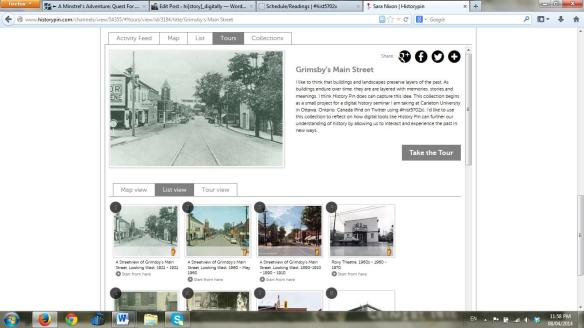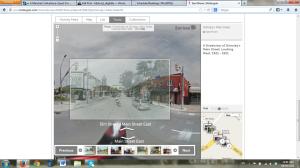Sara's Story
If anything #hist5702x has challenged me, as a historian, to think about history through different, untraditional, lenses and to do history using different, untraditional, approaches. History can be explored, approached, engaged with and understood through digital platforms and using digital technologies. I have been inspired by the idea that historians should not be confined to paper and the written record, and that representations of history which transcend traditional academic boundaries and extend into the digital world can actually be more meaningful and engaging for its audience. I’ve been especially struck by our discussions of how the digital world invites users to experience history as a way of learning, to interact with history as a way of understanding and critically thinking about people, events and places of
the past. I’d like to use this space then, the final post for #hist5702x (which will also be the longest, you’ve been warned!), to reflect on this ideas a bit more deeply. While I will draw upon our processes and experiencing developing our Air Canada AR booklet, I also want to use this space to engage with other digital history platforms that invite historians to do history differently. To meaningfully capture my own journey and how my relationship with the digital world has evolved, I figured I had to do digital history myself, to actually create, using digital the tools and technologies we’ve been introduced to throughout this course.
To use a different method to consider the ideas and issues that stood out in my learning this semester, I entered all of my #hist5702x blog posts into Voyant Tools, a web-based platform that allows users to analyze text. This digital tool,
while confirming what I already know, provides an appealing visual display of the most frequent words I use in my blog post. I chose to reflect on what I found through Voyant in a Tapesty,a simple digital storytelling tool that invites users to interact with story by clicking, or tapping, to move forward in the story. Check it out! (or see below.)
A Journey Through #hist5702x Blog Posts
Both Voyant and Tapestry offer more engaging and interactive experiences of text, they encourage an element of fun and play. But, sometimes I wonder if Digital Humanities (DH) puts too much emphasis on play, and not enough on critical reflection and analysis of the digital tools and platforms it uses or creates. I mention some of the limitations of Voyant Tools in my Tapestry production, but even Tapestry as a platform for telling stories has limitations. Tapestry’s framework only allows creators to tell a story that moves forward, in one direction. It gives users only one choice, and their interaction is very limited and controlled by the constraints of the platform. Such limitations, however, do not seem to be addressed in the DH literature. Rather, digital tools like Tapestry and Voyant are vehemently celebrated in the DH circle as innovative and exciting alternatives to the boring history book. No questions asked, no looking back.Furthermore, members of the DH community do not seem to use these tools and platforms for new analysis or critical thinking, but, it seems in most cases anyway, for new ways of doing what academics would have traditionally done in a book or essay. DHers’ work is presumed finished once the fancy digital thing is made – and it is left it at that. We
seem to be okay with this. When Tom Scheinfeldt addresses the ‘so, what’ of digital humanities (or as he says, “where’s the beef?”) in his article “Theory, Method & Digital Humanities,” he simply suggests that right now, the discipline is not interested in answering this big questions. It is still trying to fully understand and develop its methodology: its tools and frameworks, and how to use them. According to this argument, we must practice first, and theory will then follow.
From the very beginning of the semester, Dr. Graham encouraged us that the value of DH lies in the process and experience in doing digital history, rather than the final product of the digital tools we create. I found this compelling, but also unnerving. I didn’t realize how much I’ve come to find solace in that feeling after handing in the crisp paper of a well-polished essay – an academic high I clearly craved. When writing a paper, the final product is the whole point. Your audience here doesn’t pay attention to how you got to that final piece, just whether that final piece was worth their time to read. In the DH circle however, your audience wants to know about your process, experience and
learning as you work with digital tools and technologies. As the field is still figuring out its methodology, as Scheinfeldt suggests, it is relies on digital humanists to share their successes, failures, mistakes, fixes, and how-to instructions. To contribute to the DH circle then, the #hist5702x class made sure to be transparent about our
processes and experiences in developing the Air Canada AR Route augmented reality book. We shared our trials and errors through our blog posts and on twitter using the (you guessed it) #hist5702x hashtag. We shared our 3D models of the Canada Science and Technology Museum’s Air Canada artifacts, and how these developed and improved as we refined our techniques and worked through what worked, what didn’t and why. We were able to reach DH circles throughout Canada, the United States and even the U.K and Europe through retweets and replies. We got conversations starting and shared resources through twitter and blogging. I found this really neat. Extending own processes of learning to social media platforms invites others to follow and engage with these processes, and learn from them too.
If the final product of the digital history tool or platform is not the most important element of the DH process, then I don’t think we are doing digital history for the public like we say we are. I know that the #hist5702x team did not actually develop our Air Canada AR project for the public. We had the public in mind as we developed our stories and
analyses, but wider public audience will not see this digital project, for now at least. We created this to convince the management at Canada Science and Technology Museum of the value of 3D modelling and augmented reality technology. We wanted to show all the cool things we could do with AR: our 3D models of artifacts, the blogs, videos and audio recordings we created, and the websites we were able to link to the augmented tracking images in our AR Route book. Yes, we did develop this project with the hopes that one day something similar would be used at the museum, for public audiences, but the actual public was never our audience here.
Throughout the semester, I’ve repeatedly found myself returning to the ideas of how the digital world can create a more meaningful embodied experience of history. This is the direction I see my relationship with the digital world going, and this is the part of my journey that I’ve been most moved by. I was drawn especially to Stuart Eve’s article
“Augmenting Phenomenology: Using Augmented Reality to Aid Archaeological Phenomenology in the Landscape”, where he used phenomenological approach to augmented reality to suggest that such digital tools can engage our senses, and our experience of a landscape or environment. This idea that the digital world can offer another way of knowing and understanding a physical place, to experience time and space, has really changed my whole approach to even my own research. I wanted to play with some of these ideas by creating a History Pin channel for Grimsby’s Main Street; by doing digital history and sharing it with the public as well as the DH circle (well, whoever is interested enough anyways).
History Pin allows you to overlay old images over present spaces using the Streetview tool in Google Maps. This allows the user to trace change over time in a particular space by actively moving through the images pinned in a certain place by clicking their mouse. Users can also employ the fade tool to decrease the opacity of the overlayed image and actually compare changes in a place. I think this invites a level of engagement and reflection as users visually see these changes. I pinned several old photographs of the buildings lining Grimsby’s Main Street onto Google Maps Streetview of the street to trace how the town’s downtown streetscape has changed over time. You can take a ‘tour’ of my project here.
The textbox accompanying each image allowed me to tell a narrative of each building and its meaning for the local community members in the past, as well as what they mean to the community today.
The History Pin platform does have its challenges. The creator is confined to the frame of Google Maps and Streetview, and archival images are not always taken at the same angles as Streetview camera. It is also difficult to engage the senses using this platform. Users only experience the past through their computer screen, they are not in the physical space itself. Nonetheless, I would argue that the ‘so, what?’ of this History Pin project is its invitation for audience engagement. Sharing this project with the Grimsby community, I hope to encourage users to engage with their local history and to reflect on what this past means to them. I hope to encourage users to rethink their own
connections to their community and the memories they share in Grimsby’s Main Street – to engage with the story being told through the ‘tour’, to recall memories and to reflect on personal meanings and attachments to
the space, and to encourage sharing among others.
This is the kind of ‘doing’ in digital history that I find most valuable, to engage the public and to change the way that they think about history. In creating this History Pin project, I was also able to achieve the goal I came into this course with. I’ve learned the ways in which I can use digital tools to digitally visualize the memories, meanings and stories of the past people attach to physical spaces and landscapes. I developed one of these tools. I did digital history, and I am really quite moved by how much my relationship to the digital world has evolved.
| Previous page on path | A History of our Learning: #hist5702x Digital/Public History, page 3 of 7 | Next page on path |


Discussion of "Sara's Story"
Add your voice to this discussion.
Checking your signed in status ...